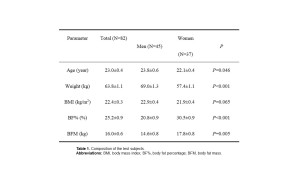Congress:
ECR25
Poster Number:
C-11105
Type:
Poster: EPOS Radiographer (scientific)
DOI:
10.26044/ecr2025/C-11105
Authorblock:
T. Zhang, Y. Gao, L. Qiu; Chengdu/CN
Disclosures:
Tianhui Zhang:
Nothing to disclose
Yang Gao:
Nothing to disclose
Li Qiu:
Nothing to disclose
Keywords:
Musculoskeletal system, Ultrasound, Experimental investigations, Outcomes
Men volunteers weighed more than women (P<0.001), with no significant difference in BMI between men and women (P=0.065), but men had lower BFM than women (P=0.005), as depicted in Table 1.

Table 1: Composition of the test subjects.
Abbreviations: BMI, body mass index; BF%, body fat percentage; BFM, body fat mass.

Fig 2: (A) Fat thickness of men and women in the routine posture. (B) Fat thickness in the site 7 (posterior upper arm) and site 8 (sub-scapular positions). (C) Fat thickness in the site 10 (posterior lower leg).
Note: ***p≤0.001 indicate there was a statistically significant difference, ns p>0.05 indicate there was not statistically significant difference.